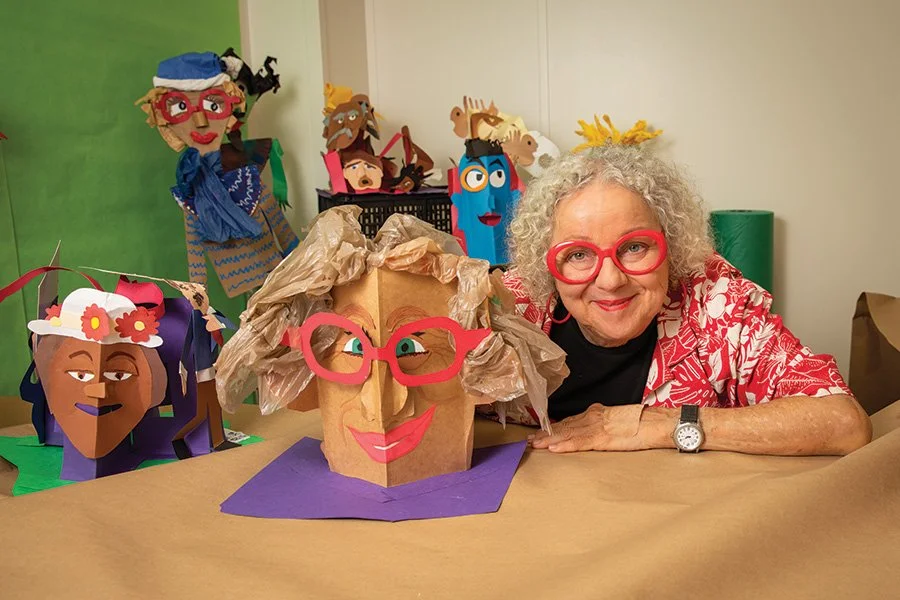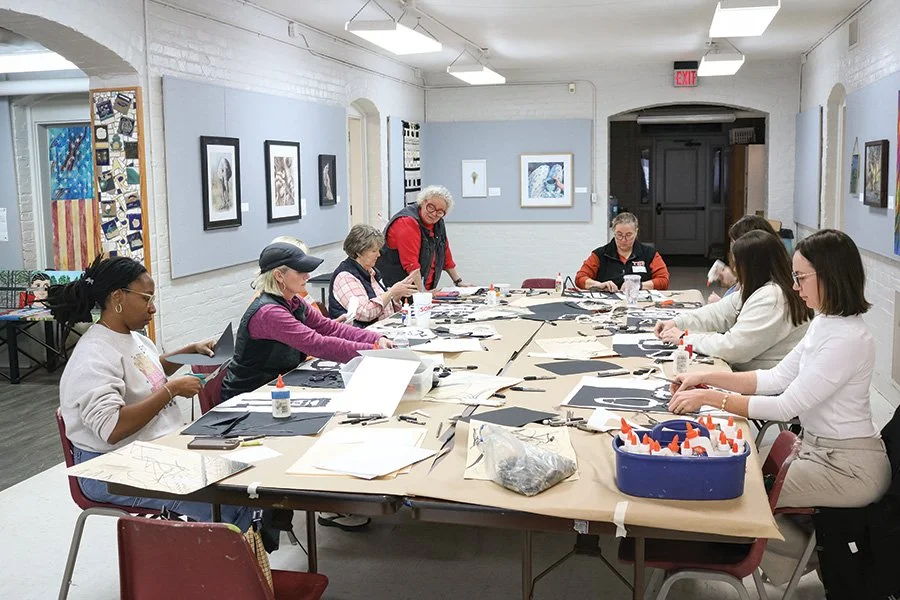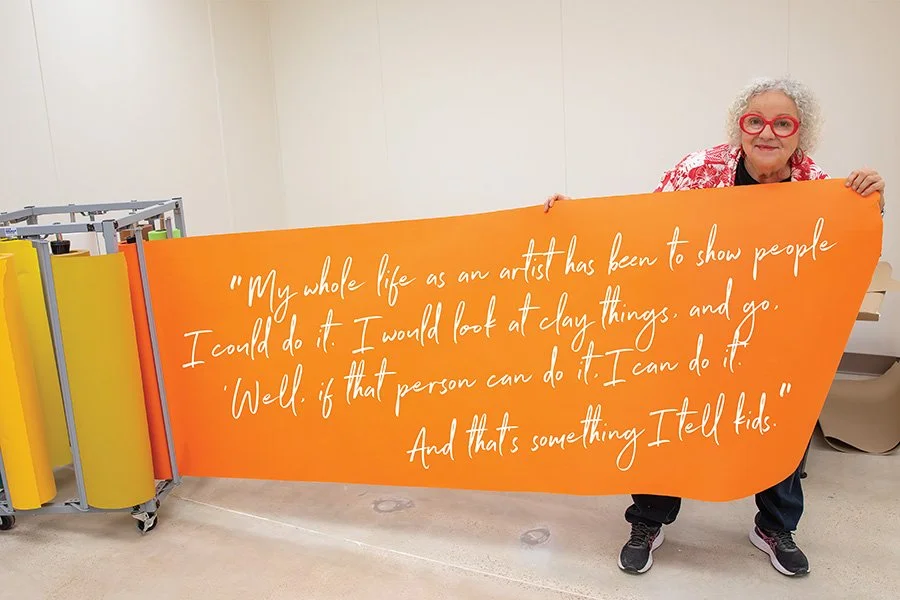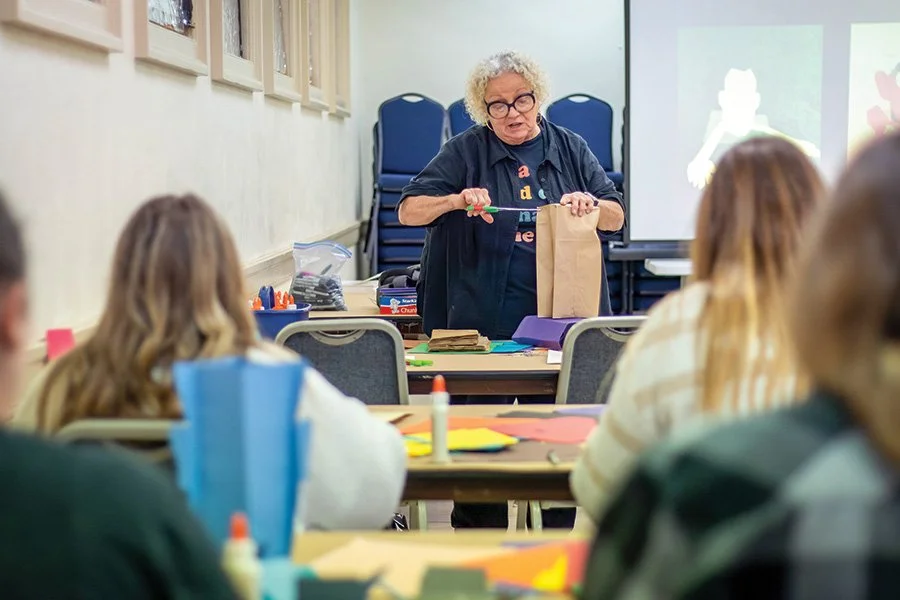A Spark for the Arts
/Artist Kay Thomas inspires others to “reclaim their right to create”
By Brandon Shoemaker
photo by shane darby
At 71, Kay Thomas is busier—and bolder—than ever. A lifelong artist, educator, provocateur, and national arts integration specialist, Kay doesn’t show any signs of slowing down. In fact, she seems to be hitting a new creative stride.
“I’m at the top of my game,” she said. “I know how to build pretty much anything I want to build. It’s just—do I have the strength to do it? But I never expected my career to explode with such success at age 71.”
Strength, it seems, is no problem. In between sculpting, lamp-making, working with teachers across the country, consulting for the Kennedy Center, and dreaming up her next wild artistic project, Kay is shaping not just clay and paper but also minds. From her roots in East Texas to classrooms and studios nationwide, she’s always been on a mission: to move people to create, especially when they think they can’t.
Born to Create
Kay’s journey began in Texarkana, Texas, where she was raised in a creative household. Her father, an architect, brought home sand for her to play in and took her to construction sites, which fostered an early-developed appreciation of architecture as an artform. By the time she was 3, she was already drawing, painting, and digging up clay to turn into sculptures.
“I was both 2D and 3D from the very beginning,” she said. “My art historian brother said, ‘You didn’t have a choice. You just were an artist.’”
Kay’s mother, a third-grade teacher, was a strong advocate for her artistic drive and introduced her to the concept of the teachable moment. She modeled in her own classroom how the arts could be woven into education—a philosophy that Kay would later adopt and expand into a national career.
Ceramics became her primary medium in high school. “I came home and told my mom, ‘This is it. It’s clay,’” she recalled. She went on to earn a BFA and an MFA in ceramic—one of only five students chosen out of 200 applicants to attend Arizona State’s graduate program based on her portfolio.
Audacity in Clay
Describing her style, Kay laughed: “A professor once told me I’m a ‘Funk Mannerist.’” The label fits. Her work is unapologetically loud, funny, and layered in meaning—what she calls a celebration and satire “of American consumer bad taste.” A small sampling of her works: a lamp adorned with cats, complete with cat paws as the feet of the lamp; a monument to Tammy Faye Messner (Bakker) featuring mascara-wielding cherubs; and a Bill Clinton–inspired lamp (the shade reads, “I did not have sex with that woman,” and when lit, reveals, “I have deceived everybody, even my wife.”).
“I love kitsch,” she said, “because it exists on the same extreme as great art. It’s over-the-top.”
Over the decades, Kay has crafted monuments to presidents, pop icons, pets, and TV preachers. Her political lamps are biting and hilarious. Her cat reliquaries and her plans for a killer poodle sculpture are equal parts sentimental and disturbing.
Each piece is both a technical feat and a statement, requiring engineering savvy and a deep understanding of art history and symbology. “It can take me years to get the iconography just right,” she said.
Kay teaching her adult expressive drawing class. submitted photo
The Artist as Educator
But Kay is not content to make art for art’s sake. She’s an artist who teaches other teachers how to foster connections across the curriculum for their students.
While working as an artist-in-residence, Kay began noticing a trend: “Teachers were missing tons of teachable moments,” she said. She saw countless opportunities for students to make connections between art and writing specifically. “They never had kids write out a step-by-step of how they made the art . . . or a persuasive paragraph about why someone should buy your art,” she recalled, “and that bothered me.” So when she was approached by the Texarkana Regional Arts and Humanities Council (TRAHC) to work as an arts integration consultant, she knew this was the right move for her.
After Kay became their arts integration consultant, TRAHC partnered with the Kennedy Center, and Kay was chosen as one of a select few teaching artists to join the Kennedy Center’s national roster. Through that role, she has helped educators use the arts—specifically visual and sculptural forms—to reach learners who might struggle in traditional classrooms.
Through TRAHC, the Kennedy Center, and Focus 5, a national collective of Kennedy-trained art specialists, Kay teaches teachers how to help students grasp abstract concepts—like plot structure, scientific classification, and historical context—through sculpture, puppet-making, and creative writing based on portraiture. Arts integration is important for her because it “is about giving the nontraditional learner a voice,” she explained.
Kay’s workshops are part–professional development, part–stand-up comedy. She’s animated, candid, often eccentric—something that once seemed offputting to people but now is expected. “As an older artist, you’re almost supposed to be eccentric,” she said. “Now, it’s an asset.”
That eccentricity earned her the moniker of “The Electric Eel of Art.” The nickname was bestowed by a Mississippi school principal who said that Kay shocks people into creating when they think they can’t.
photo by shane darby
A Legacy in Laughter and Learning
Thomas has left her mark far beyond the gallery wall. In Texas, Mississippi, and across the country, her influence ripples through classrooms, arts organizations, and a generation of artists, students, and teachers.
Through it all, her message has remained the same: everyone is creative. Everyone can make art. You just have to reclaim the part of yourself that knew it as a child.
Considering the adults who come to her workshops afraid to pick up a brush, unsure of their own ability, she said, “I tell them, ‘Use your non-dominant hand.’ ‘Pour the watercolor.’ ‘Make a mess.’ I really want them to reclaim their right to create.” And they do.
Kay joked that her future plans involve being cremated and “sprinkled in several Walmarts and dumpsters where I’ve had a good fun time” (referring to diving for discarded refuse she uses as artmaking materials). But while she may need to outsource her dumpster-diving tasks these days, Kay is as lively and productive as ever and has no plans to slow down or narrow her scope.
“When I got my MFA, I didn’t want to be described just as a ceramist,” she said, “because I realized I was about more than just clay.” She’s also about theatre, teaching, costumes, satire, construction, conversation, and chaos.
Kay taught a workshop called “The Art of Paper Sculpture: Portrait Busts” for the Arts Integration Institute professional development program. submitted photo
Mostly, she’s about reaching people where they are, whether it’s in a third-grade classroom or at a national arts training institute, and giving them the confidence to make something.
Kay’s ultimate legacy, she hopes, will be one of instilling the confidence in individuals to believe that art is accessible to everyone and at any age. “My whole life as an artist has been to show people I could do it,” she said. “I would look at clay things, and go, ‘Well, if that person can do it, I can do it.’ And that’s something I tell kids.”
Kay Thomas isn’t just a working artist. She’s a force—an electric eel in a sea of predictability—still shocking people into art.




